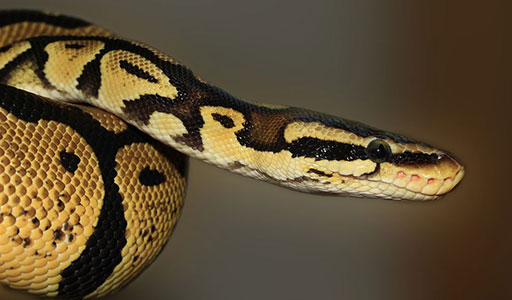Snake Removal
Do you need to get rid of snakes? We can help!

Snake Control and Removal
Finding a snake in your house is shocking. Fortunately, the worst thing a pest snake does is scare you. But that doesn’t mean you should ignore it or try to solve it yourself. Even non-venomous snakes can bite when they feel threatened.
The precense of a snake in your house is likely a symptom of a bigger problem. Snakes usually enter homes looking for food which means you could have an undetected rat or mice infestation.
If you find evidence of a snake, call Trutech in. We can remove the snake from your house and seal it from future infestations. We’ll solve the underlying issue. During the initial inspection, we’ll investigate for rodent activity. If we find any, we’ll start rodent control as soon as possible.
Our team of licensed specialists has the tools and knowledge that it takes to perform any snake control services necessary on your property. Our humane wildlife management tactics will give you peace of mind about the well-being of the animals in your ecosystem as well as your property.
Snake Problem

Signs a Snake is on Your Property
Snakes do not enter your home randomly. Snakes are in your basement, crawlspace, attic, shed or garage for a purpose. The snake is either hunting for food or escaping the elements.
Snakes avoid detection. Typical signs of snakes in your home include snake dropping and shredded snake skins.
Snakes can be a sign of a rodent infestation. During our inspection, we look for signs of snakes, rats, and mice.
Identify Snake Sounds

Dangers of Snake Infestation
The fear of snakes sometimes supersedes the actual problems associated with the pests. Some snakes feed on young chickens, though they usually target easier prey. Venomous snake bites cause pain and even fatality. When bitten, the snake-bite victim requires immediate medical attention.
Rodents can cause significant damage, spread diseases, and contaminate your food. If the snake is hunting in your home, you need to solve the rodent problem too.
Humane Snake Removal & Control Strategies

Entry into property
Snakes enter both homes and yards in search of food and shelter. Generally shy, snakes avoid human contact when possible and nest in high grasses, wood piles, decks, barns, and sheds. Because snakes cannot chew or dig, they must gain entrance through small holes and cracks.

Snake Trapping
When cornered, snakes will try to strike out and bite, so contacting a trained wildlife removal specialist is the safest option when it comes to snake control. The experts at Trutech humanely capture pest snakes to ensure the safety of all nearby residents.

Exclusions for Control
Seal cracks and holes in home foundations to reduce the possibility of snakes entering. Remove hiding places and potential food sources by taking actions like maintaining lawns, storing wood piles off the ground and in sheds or barns, sealing trash bins with fitted lids, and cleaning clutter from basements and attics. Erecting snake-proof fences around gardens and sheds is another sound form of snake control.
Rodent Control Solutions
At Trutech, we are experts at uncovering possible reasons snakes are in your home. Snakes enter homes because they are likely following a pheromone trail from a female or because there is prey within the area. If you have a snake on your property, it is not uncommon for there to be a food source like rats or mice.
During our inspection, we look for signs of rodent activity like gnaw markings, droppings, and nests. If there is evidence of a rodent infestation, you need to invest in rodent pest control with Trutech Wildlife Service.
At Trutech Wildlife Service, our skilled and certified technicians are dedicated to providing expert snake control and removal services. With our extensive training in snake behavior and control, we ensure a safe and effective removal process tailored to your specific needs.
Our commitment to humane and eco-friendly methods prioritizes your safety and the well-being of the wildlife we handle. From thorough inspections and safe removals to sealing entry points and implementing preventative measures, our comprehensive service covers every aspect of snake control.
Choose Trutech Wildlife Service for a professional, reliable, humane snake control solution. Contact us today for a free quote and take the first step toward a snake-free environment.
Snake in House
Snakes in the house typically enter either by accident or in search of food and shelter. Either way, most snakes tend to come in at the ground floor of a structure. The reptiles find entrances via gaps under doors or openings in the walls and foundations, around plumbing and vents, and even through pet doors.
Snakes prefer to hide in well-covered areas outside, including firewood piles, leaf litter, tall grasses, and rock walls. If such areas are near the structure, snakes can easily gain access to the home.
Homeowners may find snakes in various areas of the home, but most are found in basements, crawl spaces, dirt cellars, and garages. Certain tree dwelling snakes can enter into attics through holes in the roof, as well.

WHY IS A SNAKE IN THE HOUSE?
Snakes in the house find their way inside by following food sources such as mice and rats. Once snakes realize that there is an easy food source, they will move in. Finding shed skins usually points to snakes taking up long-term residence. Other times, snakes enter the home by mistake and are generally searching for a way out when homeowners encounter them.
RELATED: I WANT TO SNAKE-PROOF MY HOUSE
QUESTION:
I am interested in taking measures to “snake-proof” my yard and home.
– Fort Belvoir, VA
ANSWER:
For snake issues, we focus on removing the problem snake. More importantly, we figure out why that snake was attracted to the home. Usually, there is some food source drawing it in. Once the initial problem is resolved, we then focus on preventing other snakes from coming into the area.
In addition to sealing areas into the home, we use deterrents as well as food source reduction to help prevent future snake issues. We also offer snake removal with the preventative service, so If an issue arises, we can come out and resolve it!
Our initial service can take anywhere from a day to a few weeks, depending on how bad the problem is. The preventative services would be set up so that we would come out on a regular basis, usually every 30 days, and you would want to keep this for as long as you wanted snake control around the home.

HOW DO SNAKES GET INTO WALLS?
Snakes are nimble creatures able to squeeze into tight crevices and small spaces. They can find their way into buildings and walls through cracks and gaps in siding, windows, screens, brick, and wood foundations. The legless pests also gain access to homes and walls through drainage systems.
HOW SNAKES END UP IN THE BATHROOM?
Snakes typically enter homes in search of food or shelter from the elements. Bathrooms, specifically the spaces around toilets and drains, are ideal hiding places thanks to their high moisture levels and relative darkness. Snakes gain access to these areas via the gaps around pipes where they enter buildings, or by swimming through plumbing into toilets.
Since some home-invading species are venomous, having snakes in toilets and bathrooms is dangerous, especially when house residents are unaware of their presence. Even non-venomous snakes pose threats, as they will lash out and bite if they feel cornered or threatened.

HOW DO SNAKES GET INTO THE BASEMENT?
Snakes are long, cylindrical, and legless, which means they are not typically skilled climbers. When the pests invade homes, they must enter though openings found in the building’s foundation. This may include cracks in the bedrock, slits under doorways, pet flaps, tunnels that lead under structures, and warped siding. Once inside, snakes search for secluded locations with plenty of food and often end up in basements or crawlspaces.
WHAT MAKES BASEMENTS SO ATTRACTIVE?
When snakes enter homes intentionally, they are usually following prey or looking for suitable locations for hibernation. In the wild, the pests frequently rest in the spaces under rocks, and basements provide a similar environment. They offer consistent temperatures, moisture, darkness, relative quiet, and minimal activity, which makes them perfect for overwintering.
Property owners may also find snakes in the basement when rodent or insect infestations are present. Though different species of snakes prefer different food sources, rats, mice, and various types of insects are common prey. These pests are all commonly found in basements when they infest homes, thus making the basement attractive to hungry snakes.

HOW DO SNAKES GET INTO ATTICS?
Since they don’t have arms or legs, snakes are not typically able to climb and therefore tend to infest homes at the ground level. However, certain species, including brown tree snakes, rat snakes, and various types of pythons, are agile climbers. They can easily scale trees and enter homes via chimneys, vents, open windows, and gaps in exterior siding. Once inside, they like to congregate in spaces that see very little human activity, such as wall cavities and attics.
WHAT MAKES ATTICS ATTRACTIVE TO SNAKES?
Attics are popular denning sites for snakes because they are often home to infestations of rodents and offer seclusion from human residents. Rats, mice, and squirrels are all prime sources of food for snakes, and when property owners find snakes in the attic, they almost certainly have a rodent infestation, as well. The upper floors of homes are also consistently warm and provide plenty of cover, so snakes are able to regulate their body temperature and stay hidden.

HOW DO SNAKES GET INTO CRAWL SPACES?
Snakes typically enter homes at the ground level. Cracks in building foundations or walls larger than 1/4 of an inch in diameter are wide enough for most species of home-invading snakes to slither through and are the most common point of entrance for the pests. Vents, pipes, the spaces under doors, and gaps around utility and plumbing lines also make suitable entrances. Dark, damp locations make perfect overwintering sites for snakes, who often hole up in crawl spaces when temperatures begin to drop. In the spring and summer, the pests tend to congregate in these areas looking for food like various species of rodents and insects. If snakes feel safe and have consistent access to food, they may decide to lay eggs. Residents may find multiple snakes in the crawl space, as a few species nest together.
WHAT ATTRACTS SNAKES TO GARAGES?
Snakes are natural predators that hunt insects and small rodents. When unsecured containers of pet food or bird seed in the garage attract mice and cockroaches, it can create an ideal hunting ground for snakes. On hot, sunny days, snakes may also be attracted to the cool shade of an open garage, where they can take up residence beneath piles of junk, debris, or lumber.
Snakes in garages usually get there by slithering through an open door or a crack in the wall. However, they are also very good climbers and can enter through unsecured windows, loose roof tiles, or vents. Small opening around pipes, loose boards, and improperly sealed garage doors are all potential entry points.
WHY SNAKES ENTER YARDS
Snakes enjoy locations that offer both ample cover from predators and plenty of food. Potential food sources range from rodents and other small mammals, to reptiles and amphibians as well as insects. Many yards contain at least some form of snake food and often provide enough cover for use as shelter.
Yards harboring an abundance of food sources and sheltered locations attract high numbers of snakes and increase the potential for human encounters with the reptiles. Snakes in the grass or yard act as a form of natural pest control, but can also create undesirable outcomes.

ROBLEMS CAUSED BY SNAKES IN GRASS
People who live within the range of venomous snakes should take the pests seriously and proceed with caution in suspected habitats. Once snakes are in the yard, they can easily enter buildings, where uncomfortable encounters are likely to arise and the potential for bites increases. Snake bites are painful even when the snake lacks venom. It may be due to the possibility of a bite that creates fear of the animals. Both pets and children in snake-ridden areas are at high risk of encountering a snake in the grass, as they traditionally frequent and play in yards.
PREVENT & REMOVE SNAKES IN HOUSE
It takes a combination of different actions to keep snakes from entering the house. Exclusion, habitat modification, and eliminating potential food sources should all be used together to ensure that snakes do not get into homes.
Depending on the region of the country, homeowners may face both venomous and non-venomous snake incursions. Any cornered snake can strike whether venomous or not, making it highly advisable to contact the trained professionals at Trutech to eliminate and remove snakes in the house.
QUESTION:
I’d like to find out about snake prevention for my yard.
-Atlanta, GA
ANSWER:
Trutech can provide snake control at your property. Our first step is a visit to your home, at which point we will conduct a full inspection of your property and your home. Inspecting the inside of your home is just as important as the outside because snake activity is driven by one thing: a food source. If you have a rodent or pest control issue inside or around your home, in all likelihood, that is the reason you are seeing snakes. Inspections of both your crawlspace and attic space are vital in order to determine the snakes’ food source. During the course of our inspection, if we find any snakes, we will remove them if possible.
Following the inspection, we will recommend a snake control program based on our findings. The best way to control snake activity is to reduce their food sources. We can accomplish this by conducting a regularly scheduled pest control service in order to reduce insect activity in and around your home. If there is an underlying rodent issue, we will trap and bait to reduce that population. A snake deterrent, as well as snake traps, can also be applied and placed around your yard.
QUESTION:
I have been seeing more garter snakes and it’s causing me anxiety about maintaining and using the yard. Is there any way to be rid of them and keep them from returning?
-Wheat Ridge, CO
ANSWER:
Thank you for your question. Garter snakes follow pheromone trails of other garter snakes to find den locations and a mate. This can attract hundreds of snakes to a single area. To help control this pest, Trutech uses several methods of control such as repellants and food source reduction. As a homeowner, you also can help with the process by modifying the property landscaping. Keeping leaf litter picked up, keeping the lawn mowed, or reducing ground cover like Juniper bushes minimizes the areas the snakes have to harbor. Complete control does take time to achieve and Trutech will establish a comprehensive service to keep the snakes from becoming out of control.
Frequently Asked Questions
Salmonella is a bacteria found in the digestive systems of all types of reptiles. Items that have come in contact with their infected feces can cause food poisoning when ingested. Stemming from a bacteria common in dirt, botulism is a life-threatening illness that can also be transmitted by snakes. Since the pests spend most of their time at ground level, they are often covered in it. Despite its complicated name, campylobacteriosis is actually one of the most common bacterial infections humans get, causing diarrhea, abdominal pain, and fever. Leptospirosis also leads to flu-like symptoms, in addition to a persistent and severe headache.
Dark, damp locations make perfect overwintering sites for snakes, who often hole up in crawl spaces when temperatures begin to drop. In the spring and summer, the pests tend to congregate in these areas looking for food like various species of rodents and insects. If snakes feel safe and have consistent access to food, they may decide to lay eggs. Residents may find multiple snakes in the crawl space, as a few species nest together.
Snakes in the house typically enter either by accident or in search of food and shelter. Either way, most snakes tend to come in at the ground floor of a structure. The reptiles find entrances via gaps under doors or openings in the walls and foundations, around plumbing and vents, and even through pet doors.
Snakes prefer to hide in well-covered areas outside, including firewood piles, leaf litter, tall grasses, and rock walls. If such areas are near the structure, snakes can easily gain access to the home.
Since they don’t have arms or legs, snakes are not typically able to climb and therefore tend to infest homes at the ground level. However, certain species, including brown tree snakes, rat snakes, and various types of pythons, are agile climbers. They can easily scale trees and enter homes via chimneys, vents, open windows, and gaps in exterior siding. Once inside, they like to congregate in spaces that see very little human activity, such as wall cavities and attics.
Snakes typically enter homes at the ground level. Cracks in building foundations or walls larger than 1/4 of an inch in diameter are wide enough for most species of home-invading snakes to slither through and are the most common point of entrance for the pests. Vents, pipes, the spaces under doors, and gaps around utility and plumbing lines also make suitable entrances. After they’ve invaded, snakes look for dim, moist, and secluded areas to set up nests.
Snakes are nimble creatures able to squeeze into tight crevices and small spaces. They can find their way into buildings and walls through cracks and gaps in siding, windows, screens, brick, and wood foundations. The legless pests also gain access to homes and walls through drainage systems.
Finding a snake in the wall should always be taken seriously. Though not all snakes are venomous, the pest reptiles can still bite or strike if threatened and put small children and pets at serious risk of injury. Exclusion methods, like caulking windows or sealing cracks, gaps, or holes in foundations, are typically the best routes to take to prevent snakes in walls.
However, repeat infestations may occur without the expert knowledge of pest control professionals. Contact the wildlife removal specialists at Trutech to avoid continuous problems and eliminate snake infestations safely and efficiently.
It takes a combination of different actions to keep snakes from entering the house. Exclusion, habitat modification, and eliminating potential food sources should all be used together to ensure that snakes do not get into homes.
Depending on the region of the country, homeowners may face both venomous and non-venomous snake incursions. Any cornered snake can strike whether venomous or not, making it highly advisable to contact the trained professionals at Trutech to eliminate and remove snakes in the house.
Many people initially mistake snake droppings for bird waste, since they have a similar appearance.
Snake droppings are tubular and cord-like but may have a pinched, irregular surface. They are dark in color with pale, whitish streaks of dried urine.
The presence of snakes in yards is not likely to produce a large amount of excrement. Not only are droppings small in size, but certain species can retain fecal matter for months. As a result, even well-fed snakes may not leave much waste behind.


